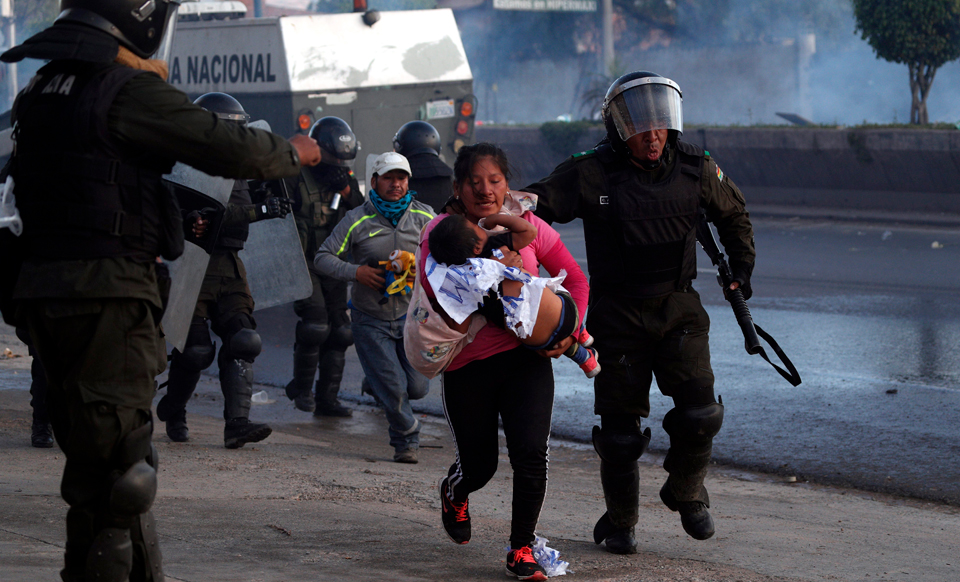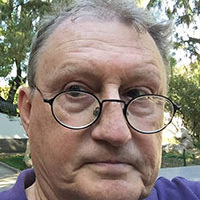
In January 1974, I was standing outside the Presidential Palace in La Paz, the capital of Bolivia. The president was General Hugo Bánzer Suárez, of German ancestry, who held old Nazi ideals. A group of Indigenous protesters demanded the end to 200% inflation, low wages, and no rice or sugar. A truckload of soldiers pulled up. They were dressed in black uniforms, resembling the old uniforms of Hitler’s SS. They opened fire with machine guns, and the bodies of men and women were thrown into the back of the trucks. 120 people were killed.
The following day, the secret service came to my hotel room and when they saw an arm patch of Che Guevara on my sleeve, they tore it off my jacket. “There is no Communism in Bolivia.” I was taken down to their headquarters and, along with others arrested, we had to stand next to a seven-meter high wall. At chest height, there were bullet holes from the firing squads.
I was given three days to get out of Bolivia, so I boarded a train at Santa Cruz headed for Brazil. On top of the roof sat Indians who could not get seats inside the carriages. As the train passed through the Mato Grosso, Indians started pouring in through the open windows. I asked one terrified man what had happened. He pointed to the forest outside. “There are soldiers out there, and they are using us as target practice.” What these two events showed me was how downtrodden the Indigenous people were in Bolivia, and how little worth the ruling white elite held for the Indigenous.
In Chile, I was arrested, taken off a bus by the military, and told to walk into the desert. I thought I was to be shot, but after being interrogated I was taken into the desert and told to keep walking. A truckload of Bolivian Indian smugglers picked me up and saved me. From these events grew my political interests in Latin America. I went onto to gain my PhD at the Institute of Latin American Studies at La Trobe University.
To understand what has been happening in Bolivia, with the overthrow of the government of President Evo Morales by an extreme right-wing coup, supported by the U.S. government, one must understand the history of racism in Bolivia, its connections with Nazism and the extreme right, and the U.S. push for neoliberal policies in the economy.
In 2005, the Movement Toward Socialism (MAS) party, led by Morales, won the presidency of Bolivia with 54% of the popular vote. He was the first Indigenous head of state in Bolivia since the Spanish Conquest.
Before assuming office, Morales went to Tiwanaku, an archaeological site outside La Paz, where he was crowned Apu Mallku (Supreme Leader) and made offerings to Pachamama (Mother Earth). He flew the wiphala flag, colored in vivid red, blue, yellow, and green, which represents the political struggle against Hispanic cultural hegemony. Morales announced: “We’re taking over now for the next 500 years. We’re going to put an end to injustice, to inequality.”
For Forrest Hylton and Sinclair Thomson, academic experts on Latin America, the election of MAS was the nation’s third revolution, following in the footsteps of the Túpaj Katari Revolt and the 1952 Revolution.
Morales dedicated his presidency to completing the struggle by the Communist revolutionary Che Guevara, who was executed on orders of the CIA at the village of La Higuera, Bolivia, in 1967. Morales announced that “the time has come to change the evil history of plunder of our natural resources, of discrimination, of humiliation, of hatred […] towards Indigenous people in Bolivia and all of Latin America.”
On May Day 2006, Morales nationalized the country’s largest gas field in Tarija. All officials and civil servants had to learn Quechua, Aymará, or Guaraní. Indigenous peoples for the first time had access to tertiary education and positions after generations of repression. These actions by Morales fermented great hatred towards MAS by the white ruling class.
For years, the Indigenous movements had faced the intense and violent political repression that accompanies neoliberalism, an economic doctrine first imposed in Chile during the Pinochet dictatorship, using what Naomi Klein describes as economic “shock therapy.”
Morales called for the repeal of the 1985 government decree which had initiated the neoliberal reforms and pledged to renationalize the privatized state-owned companies. Such attacks led to ongoing conflict with the Washington consensus: the U.S. government and the international financial institutions.
Bolivia has rich deposits of gold, silver, tin, copper, platinum, manganese, wolfram, zinc, oil and gas, and lithium. The country had been called “a table of silver supported by columns of gold,” yet the vast majority of Bolivians had one of the poorest standards of living in Latin America.
André Gunter Frank, a former adviser to President Allende of Chile, argues in Capitalism and Underdevelopment in Latin America that the colonial structure of capitalism required the Indigenous to extract minerals for the national export economy. The Peruvian Marxist José Carlos Mariátegui argues in his Seven Interpretative Essays on Peruvian Reality (1934) that in such an extractive economy, the colonial system needed the Indigenous people for cheap labor.
An important priority of the MAS government was the elimination of racism. By the time of the 1952 National Revolution, with 70% of the population being Indigenous, half were unable to speak Spanish, the official language. There are 37 ethnic groups, of which the Aymará is the dominant. Historically, citizenship was monopolized by the rich, educated, and propertied: the white and mestizo.
The Indigenous had been so degraded and had such a feeling of inferiority, that when the U.S. “Green Beret” Special Forces trained 640 Bolivian Rangers in April 1967, they made the soldiers spend hours shouting, “I’m the best” and “I’m the toughest” during drill, to build their self-confidence.
Indigenous massacres have been common in Bolivia. President René Barrientos carried out the worst massacre in Bolivia’s mining history in 1967. The military officers responsible had close ties with the Nazi war criminal Klaus Barbie. The anthropologist June Nash saw the bodies of the dead being burnt in ovens to remove the evidence. General Hugo Bánzer Suárez seized power in a military coup in 1971. Three years later, he ordered the killing of 200 people at Cochabamba in what is known as the “Massacre of the Valley.”
Bánzer formed an exclusively military regime, ending a pact with the MNR (Revolutionary Nationalist Movement) and the FSB (Bolivian Socialist Falange). His regime became internationally recognized for its brutal suppression of political activism. Bánzer was part of the notorious Operation Condor, which assassinated dissident refugees. For his great work, in 1988 the U.S. Army inducted Bánzer into its School of Americas Hall of Fame. The school is infamous for training Latin American military personnel which later carried out some of the worst atrocities of the Cold War.
In 2000, “The Water War” began when workers battled police against the corporate ownership of all water resources in Bolivia, including village wells. In 2003, “The Bolivian Gas War” began with the demand for the nationalization of the natural gas industry. Protesters cut the natural gas supply to La Paz and 54 Aymará were killed by the military.
Demonstrations of 500,000 people forced President Gonzalo Sánchez de Lozada, known as “Goni,” to flee to Miami, Florida, fearful of being tried for the death of 70 people killed at demonstrations. He had been strongly supported by the U.S. government.
These insurgencies set in place an Indigenous insurrection, which culminated in Morales’s 2005 victory. The UN Economic Commission for Latin America and the Caribbean (ECLAC) found that MAS had made significant improvements in poverty reduction.
As Hylton and Thomson rightly state: “In no other Latin American country have popular forces achieved so much through their own initiatives.” Now Morales has fled to Mexico. He resigned his presidency on Nov. 10, after threats from the military commander Williams Kaliman, who had also been trained at Fort Benning, previously known as the School of the Americas.
The coup was financed by the Pro-Santa Cruz Committee under its president Luis Fernando Camacho, well known for his hatred of Morales. His company was listed in the “Panama Papers,” for laundering large sums of money in offshore accounts. After Morales fled to Mexico, Senator Jeanine Añez assumed the position of interim president, and she was congratulated by Mike Pompeo, the U.S. Secretary of State.










